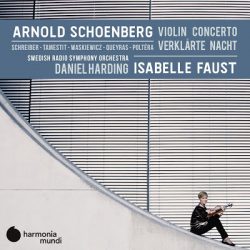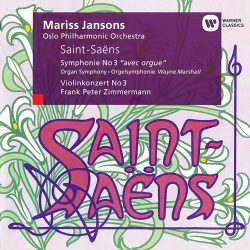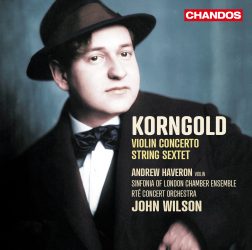Classical CD Reviews: Isabelle Faust plays Schoenberg, Mariss Jansons conducts Saint-Saëns and Poulenc, and John Wilson conducts Korngold
By Jonathan Blumhofer
Isabelle Faust makes Arnold Schoenberg’s thorny Violin Concerto sing; Mariss Jansons lends heft to Saint-Saëns’s Symphony no. 3, and John Wilson continues to be your go-to conductor for Erich Wolfgang Korngold.

You can count on violinist Isabelle Faust to never settle for the predictable. So the fact that her new recording of Arnold Schoenberg’s thorny Violin Concerto draws such compelling detail and life out of this dense late-1930s score probably shouldn’t come as a surprise.
True, Faust has got an ability with even the knottiest 20th-century fare that few musicians can rival. But this piece is a particularly formidable challenge: the Schoenberg Concerto gives us the composer in his most soberingly Serialistic mode. Despite this, Faust gets the piece to sing – if not quite like Brahms, then maybe like Brahms’s grand-nephew.
What comes out in her reading with the Swedish Radio Symphony Orchestra (SRSO) is the music’s underlying lyrical impulses as well as its devotion to tradition, particularly its echoes of gestures from Bach, Beethoven, and – yes – Brahms.
The first movement is played with a clarity of line that is simply breathtaking, Faust navigating the music’s wickedly complex triple-stops and angular melodies with an almost majestic sense of character and fervent expressivity.
In the shapely second, Faust gracefully underlines Schoenberg’s dancing rhythms, and her take on the finale brims with schwung.
Daniel Harding leads the SRSO in a lean, characterful accompaniment, one that emphasizes the dazzling colors of Schoenberg’s orchestration and doesn’t lack for structural direction or good balances between soloist and orchestra.
The rest of the disc is given over to a lush, electrifying account of Schoenberg’s Verklärte Nacht. Even after he’d written pieces like the Violin Concerto and Moses und Aron, Schoenberg’s reputation rested on this 1899 tone poem.
The present performance of the original string sextet version – in which Faust is joined by violinist Anne Katharina Schreiber, violists Antoine Tamestit and Danusha Waskiewicz, and cellists Christian Poltéra and Jean-Guihen Queyras – shows just why that was the case. Fluent in tempo, exquisitely balanced, and, in the tenderest moments, shimmering like the sun glinting off dewdrops, it’s a reading that, for 27 too-short minutes, simply beguiles.
 This is a conspicuously fine Mariss Jansons album.
This is a conspicuously fine Mariss Jansons album.
On the one hand, the late chief conductor of the Bavarian Radio Symphony Orchestra (BRSO) makes Camille Saint-Saëns’s Symphony no. 3 sound like something it doesn’t often seem to be: a serious, bold essay by a composer who’s often regarded as a lightweight.
How does he manage it?
First, by broadening out tempos: this is no speed-demon “Organ” Symphony. But when it’s played with the conviction and focus that Jansons and the BRSO brings to it, the piece needn’t be. Indeed, Jansons’s approach to the score draws out the Symphony’s latent contrast of tragedy and triumph.
His take on the first movement is flexible and surging. The second is tight and blazing. Organist Iveta Apkalna provides a discreet account of her part in the former and anchors – but somehow doesn’t superimpose herself on the proceedings in – the latter. It’s a delicate, but successful, balance.
The other element this Saint-Saëns Three has going for it is an uncommon sense of shape and dramatic progression. There’s nothing tentative about the BRSO’s playing here but, in the outer halves of each movement, the orchestra holds back appropriately; the majestic finale, as a result, features a terrific sense of arrival and catharsis – a victory hard-won – as a result.
The Poulenc Organ Concerto that follows is similarly sober and intense. Apkalna draws out the dark colors of the opening Andante and the slow third movement sings like a consoling hymn. In the score’s faster sections, she ably emphasizes the music’s rhythmic elements – but never at the expense of the score’s tragic mien.
Jansons’s accompaniments in the Concerto’s fast movements are rhythmically taut and bracingly colorful, while the music’s naturally lyrical voice flows freely throughout. As in the Saint-Saëns, balances between organ and orchestra are smartly calibrated and the collective ensemble’s sense of pacing is impeccable.
In all, then, here’s a release that lives up, musically, to the BR Klassik’s technical excellence.
 John Wilson is your go-to conductor for Erich Wolfgang Korngold. Last year’s account of the Symphony in F-sharp was superb. This year’s take on the Violin Concerto and String Sextet is just as fine.
John Wilson is your go-to conductor for Erich Wolfgang Korngold. Last year’s account of the Symphony in F-sharp was superb. This year’s take on the Violin Concerto and String Sextet is just as fine.
For the Concerto, Wilson and the RTE Concert Orchestra have violinist Andrew Haveron as soloist. His tone is pure, fingerwork precise, and sense of the music’s swashbuckling character flawless. For sweep, playfulness, and command of the Concerto’s structure – not to mention total emotional engagement – Haveron’s reading sits right at the top of the heap with Gil Shaham’s and Baiba Skride’s.
Wilson teases out playing of glimmering beauty from his orchestra: they revel in the cinematic touches of Korngold’s writing – the radiant percussion scoring, lush string dissonances, gamboling gestures, and the like – while never drawing undue attention to themselves or distracting from the involved solo writing.
The Sextet that follows carries along in a similar vein, with brawny accounts of the outer movements, a fervent reading of the Adagio, and a sweetly lilting take on the charming “Intermezzo.”
In the end, the whole thing’s a lustrous celebration of one of the last century’s greatest and most technically brilliant composers. Don’t miss it.
Jonathan Blumhofer is a composer and violist who has been active in the greater Boston area since 2004. His music has received numerous awards and been performed by various ensembles, including the American Composers Orchestra, Kiev Philharmonic, Camerata Chicago, Xanthos Ensemble, and Juventas New Music Group. Since receiving his doctorate from Boston University in 2010, Jon has taught at Clark University, Worcester Polytechnic Institute, and online for the University of Phoenix, in addition to writing music criticism for the Worcester Telegram & Gazette.

Jonathan, to which recording of Saint-Saëns’ third symphony have you listened?
I hope it is the BRSO’s recording, but the illustration shows Jansons’ much earlier registration with the Oslo Philharmonic (which is also excellent).
Keep up the good work.